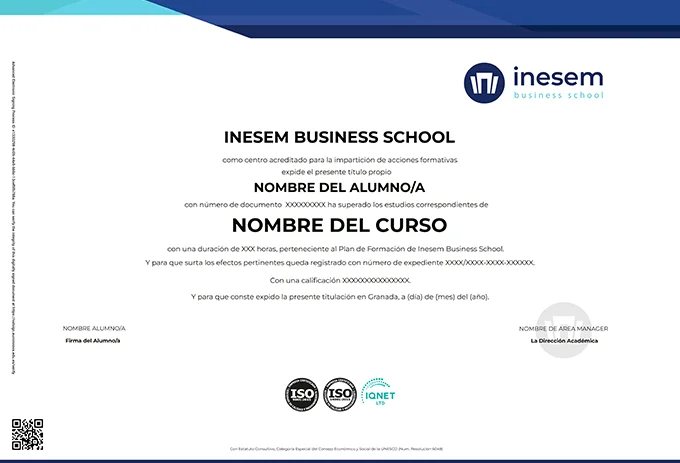- Presentación
- Temario
- Metodología
- Titulación
Descripción
¿A quién va dirigido?
Objetivos
Salidas Profesionales
Temario
UNIT 1. GGPLOT2 AS A LIBRARY FOR DATA VISUALIZATION IN R
- Introduction to Gplot
- The ggplot2 package
UNIT 2. AXES
- Changing axis titles
- Increasing axes spacing and axes titles
- Changing the aesthetics of Axis titles
- Changing the aesthetics of Axis text
- Rotation axis text
- Deleting axis text and marks
- Deleting axis titles
- Axis range limit
- Forcing the plot to start at the origin
- Axis with the same scale
- Using a function to modify labels
UNIT 3. TITLES
- Adding a title
- Positioning of the titles
- Using a non-traditional font in your title
- Changing spacing in multi-line text
UNIT 4. LEGENDS
- Working with legends
- Removing legends
- Removing legend titles
- Changing the legend position
- Changing the legend direction
- Changing the legend title style
- Changing the legend title
- Changing the order of legend keys
- Changing legend labels
- Changing background boxes in the legend
- Changing the size of legend symbols
- Leaving a layer outside the legend
- Adding legend elements manually
- Using other legend styles
UNIT 5. BACKGROUNDS AND GRID LINES
- Changing the background color of the panel
- Changing grid lines
- Changing the spacing of grid lines
- Changing the plot background color
UNIT 6. MARGINS
- Working with margins
UNIT 7. MULTI-PANEL PLOTS
- Working with multi-panel plots
- Creating small multiples based on a variable
- Allowing axes to roam free
- Using facet_wrap with two variables
- Modifying the style of the strip texts
- Creating a panel of different plots
UNIT 8. COLORS
- Working with colors
- Specifying individual colors
- Assigning colors to variables
- Qualitative Variables
- Manually selecting qualitative colors
- Using integrated qualitative color palettes
- Using qualitative color palettes from extension packs
- Quantitative Variables
- The Viridis color palette
- Using quantitative color palettes from extension packs
- Modifying color palettes after assigning data
UNIT 9. THEMES
- Changing the overall plotting style
- Changing the font of all text elements
- Changing the size of all text elements
- Changing the size of All line and rect elements
- Create your own theme
- Update the current theme
UNIT 10. LINES
- Adding horizontal or vertical lines to a plot
- Adding a line within a plot
- Adding curved lines and arrows to a plot
UNIT 11. TEXT
- Adding labels
- Adding text annotations
- Using Markdown and HTML Rendering for annotations
UNIT 12. COORDINATES
- Flipping a plot
- Fixing an axis
- Reversing an axis
- Transforming an axis
- Creating circular plots
UNIT 13. TYPES OF PLOTS
- Alternatives to a box plot
- Adding a rug to a plot
- Creating a correlation matrix plot
- Creating a contour plot
- Creating a heat map
- Creting a ridgeline plot
UNIT 14. RIBBONS
- Working with ribbons (AUC, CI, etc.)
UNIT 15. SMOOTHING
- Adding a LOESS or GAM smoothing
UNIT 16. INTERACTIVE PLOTS
- Working with interactive plots
Metodología
EDUCA LXP se basa en 6 pilares
Titulación

INESEM Business School se ocupa también de la gestión de la Apostilla de la Haya, previa demanda del estudiante. Este sello garantiza la autenticidad de la firma del título en los 113 países suscritos al Convenio de la Haya sin necesidad de otra autenticación. El coste de esta gestión es de 65 euros. Si deseas más información contacta con nosotros en el 958 050 205 y resolveremos todas tus dudas.
Explora nuestras Áreas Formativas
Construye tu carrera profesional
Descubre nuestro amplio Catálogo Formativo, incluye programas de Cursos Superior, Expertos, Master Profesionales y Master Universitarios en las diferentes Áreas Formativas para impulsar tu carrera profesional.
Course on Data Visualization in R with ggplot2
